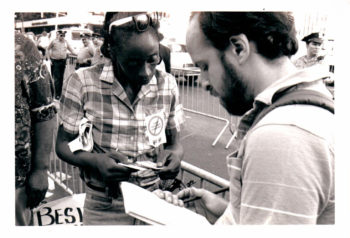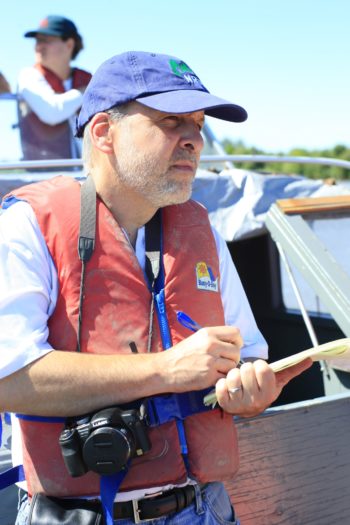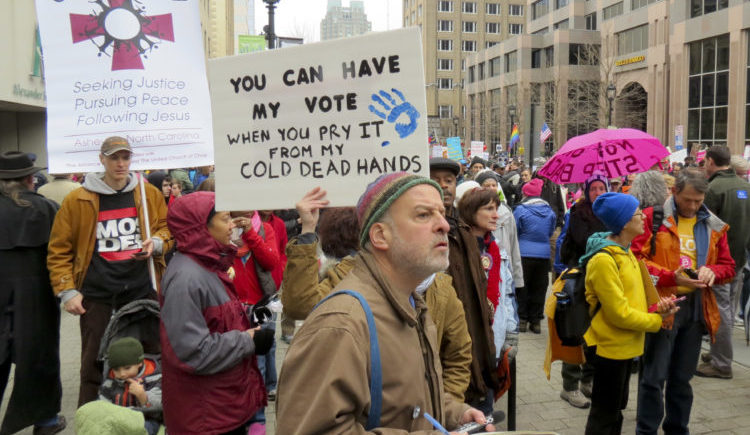EDITOR'S NOTE: We came across this interview with freelance journalist Barry Yeoman on the Creatives in Conversation site, run by Allison Kirkland, and are so glad we did. Because now we know about one more place to find a community of like-minded storytellers, and because Yeoman — a talented, thoughtful, generous and practical journalist — has valuable things to say. We are republishing it here, with permission and gratitude.
Creatives in Conversation: I believe that we can learn so much from each other and I am fascinated by the ways in which artists of all mediums move through the creative process. Each month I feature a different local artist as we discuss the challenges and joys that come from accessing and living with their creativity. ~ Allison Kirkland
Barry Yeoman is a freelance magazine journalist based in Durham, NC. Barry specializes in longform narrative that puts human faces on complex social, political, environmental & racial issues. He also dabbles in audio, and collaborated with Richard Ziglar to produce four hour-long radio documentaries about Southern roots music, including 'Still Singing the Blues' and 'Zydeco Nation'. Columbia Journalism Review had this praise for Barry’s work: “(One of) the best unsung investigative journalists working in print in the United States … Yeoman specializes in becoming a part of his subjects’ lives; he works hard to dispel the image of the parachute journalist who drops in, grabs the story, and runs.” Barry occasionally teaches writing and journalism at Duke University and Wake Forest University.
You're a journalist first and foremost, but are there any other ways in which you’d describe yourself professionally?
That's an interesting question because I think if you asked me early in my career, I would not have said I was a writer. I definitely entered journalism through the newspaper, the adrenaline rush of chasing the story aspect to it. And so when I moved here and started working for the Indy in 1986, it took two editors to make me their project and take me from being a very good reporter for whom writing was secondary to really appreciating language and the creative part of the process, which I had always thought of as secondary.
As I have gotten deeper into the long form magazine freelancing phase of my career, I've definitely owned “writer” more as a title. And because I am working more and more in audio, I find myself adding “audio documentarian” to the list. And just as I had an early career infatuation with words that was not there originally, I find myself having a later career infatuation with sound. I'm certainly not an artist at the level of engineering sound; I don't do that except dabbling around. But I can put together a heck of a documentary script. And I find that I hear sound in different ways as a result.
How do you think documentary script differs in form compared to something like a journalistic piece?
It's necessarily more sensory and it requires more precision. If I'm talking to you and you're saying something that's interesting but not well phrased, I can rephrase it for you. [For example] She told me that she did this as opposed to quoting you. You don't get that much leeway in audio. You can splice things, but not that much. And you can paraphrase a little, but not that much. So it requires a kind of discipline that's more unforgiving.
How did you originally become interested in audio documentation?
Accidentally. (Laughs.) I was working on a story for AARP [about older people] in the wake of Hurricane Katrina. And back then, [AARP] sometimes flew me up to DC just so I could meet with my editor before I started. I was meeting with [my editor], and the head of AARP's radio division popped her head into the office and said if I give you a Marantz recorder and I find you someone who will give you a quick lesson using it, will you also record people so that we can maybe create something for this weekly show we produce, which was called Prime Time Radio.
And I said sure. And they basically sent me into the very worst radio conditions. People were living in FEMA trailers, which are like tin cans anyway. Louisiana is hot, so air conditioners were running and the subjects were older. So you couldn’t turn off the air conditioning. And the first thing you're supposed to do when you go into someone's house [to record audio], is not just turn off the AC but also unplug the refrigerator and turn off the ceiling fan. So I was doing the dirtiest audio you could imagine. And they assigned me to a producer who turned it into this beautiful hour-long documentary. And in the process she, she told me, Oh, by the way, you're narrating.
And I said, have you noticed I have a stutter? And she said, oh yeah, don't worry about that. And we kept on going. And then then there was another project with AARP. And then there was a story that I couldn't place in a magazine, and audio producer Richard Ziglar said, let's apply for a grant from the Louisiana Endowment for the Humanities. And we got it. And then we got another grant from California Humanities and it just built.
When you began with journalism, with the thrill of chasing a story, and then you branched into thinking more about the craft of writing, was there one specific incident that sort of tipped the scales for you?
There were several, but I'll tell you the first. This was in my early years at the Indy. I had done a story where I was traveling around North Carolina trying to get a pulse on the public with an election coming up. I had identified people who supported many of the candidates who were running for US Senate that year and I talked with this sort of cross section of North Carolina voters.

But of course, because I was traveling, something else happened in the process, something unpredictable, born of stopping into country stores to get gas and falling into conversations that didn't fit into the clean narrative. In journalism school, I had had first-person just beaten out of me. That's not something journalists do. But my editors specifically urged me to write at least part of the story in first person and something cracked in that process. I showed a draft to a friend and he started crying and I listened to that. And then the same editors proceeded to put me through a series of paces over a few years that tried to get me to the next level and the next level and the next level.
I spent a week at an abortion clinic in Raleigh working on a story not on the women getting abortions, but on the workers at the clinic during a particularly fraught time politically in North Carolina. And when I wrote the first draft it was immediately apparent to my editor that I was shielding my emotions because it had been so overwhelming. There was a kind of stiffness to the writing that was just me putting up a wall. And so she just sent me home and she said, I want you to just write about what the clinic smelled like. So I wrote that and I came back and then she said, I want you to go home again and write about the sounds, write me the soundscape of this clinic. I did that. And then she said, go home and write how you felt when you were there.
And what we were doing was building an arsenal of material that I had not included the first time and which got increasingly more intimate with each trip home. It was slowly chipping away at that wall. And it worked. And another time I had a similar blockage and one of my editors urged me to spend a day walking in the forest and just thinking. Because again, you know, the journalistic pattern is just rush, rush, rush, react. And so this notion of slowing down to process was something I had to learn.
I love getting that perspective from someone who's been trained one way and then sort of taught to integrate with other ways. So we're going to get into some broader questions. What does living a creative life mean to you?
For me it's hard to separate out the creative and the practical. Because if you do separate that out too much, you end up essentially having two lives: the life that is lived in absolute pursuit of craft and the life that is mercenary. And I don't want to divide my time that much.
My field of journalism is dying as we know it and it has never been more important. And so my challenge is how do I remain nimble in the face of that?
Wendell Berry talked about the farm as the ideal because of the integration of work and living in a single space. And for me that is a valuable construct, because I want as little separation between my work life and my home life -- not because I want to be working 24 hours a day, but because I've never fashioned myself as someone who puts on a fancy shirt and gets on the train to an office.
The thing that interferes of course is the reality of the market. And so for me, living a creative life means finding that space between the absolute creative and the absolute practical.
So you're kind of constantly weaving through a lot of different decisions to feel like you can avoid those compromises.
Yeah. Some of it is intuitive. I know that every word I write on paper I have to be paid for. I realize that there are some things I might want to write that no one will pay for. And therefore I won't write them. And I'm good with that.
That's hard.
It's less hard to me than having two hours a day when I can write anything I want and then spending eight hours a day writing technical manuals. I'd rather live a creative life that is satisfying but imperfect all the time than alternately perfect and horrible.
How do you think that we can get our country in particular and the world as a whole to value creativity more highly? And what do you think it would look like if we did?
I do think that among some people in the creative community there is a privileging of subject matter and language that is undemocratic and academic and abstract. That may be precise, but we lose an awful lot of people. And I think we need to rethink that. I think in a bigger sense we need to think about the arts as relational. It is about contract between audience and artist.
I think maybe journalists think about this more than fine artists and performing artists and other types of creative writers. But for me, finding where my audience is and then locating my work where are they are -- and maybe a little ahead of them -- is what I naturally do. Whereas I feel like a lot of artists think that type of consideration of audience is compromising and believe that art is at its best when it is the truest reflection of the mind and heart of the artist. But I do think that art is in the best of ways transactional. It is about communication. And that requires thinking about how we communicate.
What are some creative challenges that you've come up against throughout your career and how have you moved through them or are you still moving through them?
I'm still moving through. A lot of my challenges are about the changing market. My field journalism is dying as we know it and has never been more important. And so my challenge is how do I remain nimble in the face of that.

A lot of my generational peers — I'm a very late boomer — are not able to be nimble and only know one way of doing [journalism] and are finding work in other fields or suffering mightily or taking early retirement. And I feel blessed with flexibility. And so some of the pivot to audio for example, was a result of that, and knowing that I can't rely on getting eight stories a year that I know will be published in magazines and pay all my bills. Working with some interesting multimedia ventures, doing work that integrates text, audio, hypertext, interactive maps and photography has been really satisfying. That to me is the greatest challenge, although it is not strictly a creative challenge.
I think that one of the biggest purely creative challenges, well -- and as I say it, I realize there's also some marketing in here -- is that the quality of longform narrative has improved dramatically in the last few years. I feel like we're in a golden age of longform and that has upped the ante and I responded by upping my game. I like learning. I like constantly improving my craft; if I am not constantly improving my craft, why am I still doing this? And so I have been much more focused on structure, on pacing, beauty. And I think that this would have benefited me even if the standards weren't getting higher, but the fact that they are getting higher is a nice incentive.
What do you think the role of a creative or artist is within their community?
It varies by discipline. Mostly I'm thinking along the insider-outsider spectrum. Journalism [requires me] to do things that do not always make me popular in the community. It's accountability, it's hard looks, it's unflinchingly holding up a mirror. But if you are the soon-to-be-closed Carrack or if you're Blackspace or if you are any of numerous creative institutions, it is about fostering conversation, giving communities agency, expanding the visions of a community.
I think that writing is less like speaking in tongues and more like building a table.
And so I would be loath to suggest that every member of a creative community has the same role. In fact, we are complementary but often doing very different things.
What advice would you give to someone who wants to work on becoming more creative?
I can't speak to every type of creative expression, but I can talk about writing. I would say that first you must disabuse yourself of this binary notion that either you are or you are not a writer, that somehow writing is this innate gift that some people have and some people don't. And if you have it, you don't even have to practice. And if you don't, you shouldn't even try. I think that is destructive thinking. And furthermore, untrue.
I think that writing is less like speaking in tongues and more like building a table. You learn the elements of craft, at first you get the legs on backward. You try to plane the surface and at first it's a little wee-wah, but with each successive planing it gets more level. And so approaching whatever creative pursuit interests you as a craft rather than as a gift is valuable and ultimately more democratic.
As a corollary to that: learn the craft. Don't think that you can cultivate it sitting by yourself. People who want to build tables take classes or apprentice. They learn from the masters. So learn from the masters. Then set aside time. Carve out time that is sacrosanct, do not let anything interfere. Do not carve out so much time that you will be tempted to carve time out of that for something else. If it's 30 minutes day, if it's 20 minutes a day, if you're lucky it's an hour.
And don't fall prey to the myth of the solitary artist. We are communal creatures and we do best not just emotionally, but also creatively when we are in community with others who are doing similar or related work.
This interview has been edited and condensed.



